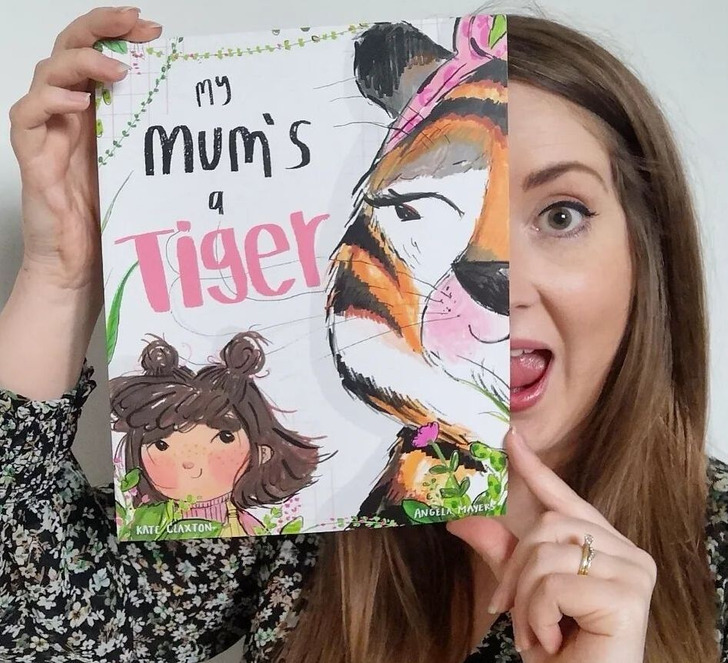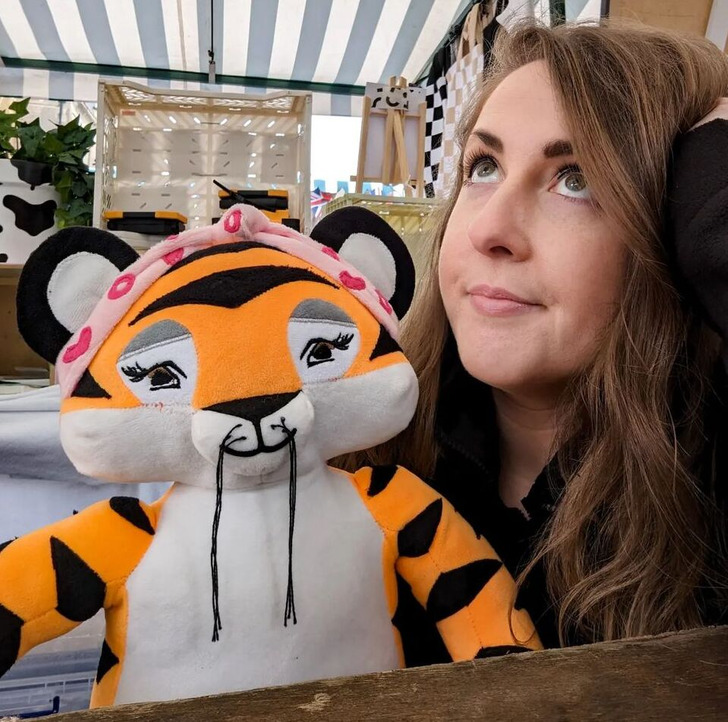In an age where unrealistic beauty standards and airbrushed images saturate media platforms, one mother’s bold decision has ignited a fierce debate. Instead of following what everyone else thinks, she did something empowering and accepting. She painted stretch marks on her daughter’s doll.
Kate writes books for kids.

Kate Claxton, is a talented author dedicated to inspiring children. Among her notable works is the multi-award-winning picture book, “My Mum’s a Tiger!” Crafted with love and a profound understanding of the challenges faced by many, Claxton created this heartfelt story as a cherished gift for her baby’s first birthday.
Little did she know that her creation would transcend personal boundaries and resonate with countless individuals around the globe. “My Mum’s a Tiger!” serves as a powerful reflection of the experiences of numerous real-life people who grew up being told that their scars, stripes, spots, and so-called ’flaws’ should be concealed.

She has body-inclusive dolls for her kids at home.

Claxton not only writes empowering books but also practices what she preaches in her own home. Recognizing the importance of body inclusivity and normalizing the beauty of individuality, Claxton provides her children with body-inclusive dolls. As much as she adores her acclaimed work, “My Mum’s a Tiger,” which beautifully embraces tiger stripes and other unique features, Claxton understands her daughter’s fascination with dolls and their ability to be dressed and undressed.
Consequently, she took it upon herself to modify one of these dolls, adding the very stripes that so many people cover up. Claxton believes in embracing differences and encourages others to do the same, offering a poignant line from her book: “Let’s take what makes us different and instead of trying to hide, let’s be more like animals and wear our marks with pride.”
Some people criticized her for painting the dolls.

Inevitably, not everyone embraced Kate Claxton’s initiative of painting the dolls. But Claxton takes pride in the fact that her Barbie craft session sparked conversations and stirred up reactions. However, she acknowledges that reading the comments can sometimes be disheartening, particularly when encountering individuals who completely miss the point.
Among the critical comments, one person questioned the motive behind painting the dolls, asking, “Why make young girls worry more about their bodies? I’ve got no stretch marks, so maybe it would be better to teach them about being positive rather than negative about their bodies.” Another comment echoed a similar sentiment, stating, “Why make girls worry more all the time? I had three kids and no stretch marks. Make them think positive.”
She doesn’t listen to the mean comments.

Despite encountering some less-than-supportive remarks, Claxton chooses to scroll past those comments, refusing to let them overshadow the positive impact and meaningful discussions her efforts have generated. While acknowledging these differing viewpoints, Claxton remains committed to her mission of promoting positivity and fostering a healthy body image in children.
Another mom that received a lot of attention for her unique parenting style was actress Kristen Bell. Known for her refreshing approach to raising her children, Bell brings a combination of compassion, empathy, and open-mindedness to the table. In a candid moment on her podcast, Kristen Bell openly shared a personal anecdote about her daughter’s developmental journey, revealing that her daughter wore diapers until the age of 5.
Preview photo credit reallyratherwild / Instagram
Meet Jyoti, Who, at the Age of 30 and Standing at 63 cm Tall, Successfully Made Her Mark in Hollywood
Jyoti Amge grew up like any ordinary child, but at some point, her growth stopped. Now 30 years old, she stands at 63 cm tall. Jyoti earned the title of the world’s smallest woman and later ventured into Hollywood, proving to everyone that a diminutive stature is not a hindrance on the path to one’s dreams.
Her childhood

On December 16, 1993, Jyoti Kisanji Amge was born in Maharashtra, India. Jyoti’s mother, Ranjana, claims that she was a normal size at birth and in her early years of childhood. Jyoti’s growth actually stopped when she turned 5 and hasn’t changed since — aside from that, she’s continued to attend school with her average-sized peers.
“She learned to walk on time, her teeth grew in on time, she learned to feed herself on time, she was a regular child for a while,” explained her mother,
Jyoti has never thought of her size as an obstacle, thanks to her family’s unwavering support. Whenever they are together, her family commonly carries her around, so she can see the world from their point of view. In fact, despite the difficulties that came with persisting in her education, her sister used to carry her around college, and that helped Jyoti finish her studies and graduate.

But Jyoti hasn’t always felt this way about her condition. “When she was not this famous, people used to tease her and make fun of her. She used to feel very dejected then,” her father spoke up. Jyoti’s perseverance and zeal mainly stem from her family, who have always backed her and supported her to continue on.
The small size of Jyoti Amge prevents her from doing most things independently. “’I can’t go anywhere by my own choice,” said Amge, who relies on family members to assist her in daily tasks. “I can’t turn on the tap, can’t open the door, can’t go to the bathroom unless someone takes me, and every time I go out, I have to be carried,” she added.
Fortunately, her condition doesn’t severely restrict her mobility or lifestyle, allowing her to lead as normal a life as possible.
The cause of her stunted growth

“Doctors think the reason behind my height not increasing is a deficiency of growth hormones.” Her condition was later determined to be caused by achondroplasia, a type of dwarfism that prevents her from growing taller than a certain height.
A Guinness World Record girl

“She may be the shortest living woman, but Jyoti Amge is one of the biggest personalities we have in the Guinness World Records universe.” Jyoti officially became the shortest woman alive (mobile) after turning 18, and achieving this record has improved her self-esteem. She has said, “I feel well-liked, special, and important.”
“Measured by a doctor, she was just 61.95 cm (2 ft) tall, confirming her as the shortest living teenager (female). Remarkably, at just 5.4 kg, she weighed only 4 kg more than her birth weight,” the Guinness World Records claimed. Everything she uses or wears, like her accessories, cutlery, and plates, needs to be customized for her. Jyoti, on the other hand, puts a lot of effort into making the most of each situation and her exceptional stature.

In 2012, Jyoti Amge met the World’s Tallest Man, Sultan Kosen, and she posed with him for the 57th edition of the Guinness World Records.
“When I met the world’s tallest man, I was a little shocked,” she claimed in an interview, “I was thinking how can be someone so tall, and he was astonished to see me as well, but we are now very good friends.”
Her success and her acting dream

In 2012, Jyoti Amge met the World’s Tallest Man, Sultan Kosen, and she posed with him for the 57th edition of the Guinness World Records.
“When I met the world’s tallest man, I was a little shocked,” she claimed in an interview, “I was thinking how can be someone so tall, and he was astonished to see me as well, but we are now very good friends.”
Her success and her acting dream

Although GWR’s recognition was crucial in helping her achieve success abroad, Jyoti has been making more efforts to realize her dreams and disprove those who think a girl of her stature can’t succeed in life.
Besides pursuing her career, Jyoti hopes to be a role model for anyone who lacks self-confidence. She hopes to inspire others to not let their differences impede their life plans. “To people like me: if you keep trying, you will definitely achieve all of your dreams.”
Here is the story of the tallest woman in the world, with a height of 215 cm. Despite the challenges that her height presents, she remains undaunted and lives her best life.



Leave a Reply